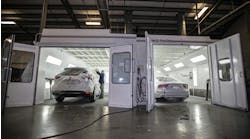Although the condition of a vehicle’s tires has implications on its overall performance and fuel economy, a recent study by the Rubber Manufacturers Association (RMA) reveals 85 percent of drivers do not properly check their tire inflation pressure.
Improper tire pressure can lead to a multitude of problems – from uneven and accelerated wear, to structural damage. With temperatures rising and many families planning for vacation travel, attention to tire care and maintenance should be heightened, according to Gary Medalis, a Goodyear general manager.
“Checking tires for proper inflation and tread condition is one of the most critical – and easiest – maintenance procedures for a consumer,” he says. “It doesn’t take much time or sophisticated equipment. Drivers can easily check their tires themselves, or any of our retail outlets would be happy to assist them.”
Goodyear recommends motorists check their tire inflation at least monthly and before long trips. Tires should be inflated to the vehicle manufacturer's recommendations printed on the vehicle door placard or in the owner's manual, not the maximum limit stamped on a tire sidewall.
According to the U.S. Department of Energy, proper inflation pressure can improve vehicle fuel economy by 3.3 percent, saving up to 12 cents a gallon at the pump.
During National Tire Safety Week, Goodyear outlets are distributing the RMA’s “Be Tire Smart, Play Your PART” consumer booklets that stress the importance of proper tire care. The company’s fleet of blimps is also spreading the message during flyovers at various events.
Pep Boys points out that the National Highway Traffic Safety Administration (NHTSA) reports that under-inflated tires are responsible for 660 fatalities and 33,000 injuries each year as it urges motorists to heed the RMA’s PART acronym, which stands for Pressure, Alignment, Rotation and Tread.
PRESSURE: It’s important to have the proper inflation pressure in tires, as under-inflation can lead to tire failure. The “right amount” of inflation is specified by the vehicle manufacturer and is shown on the vehicle’s door sill, glove box door or fuel door as well as listed in the vehicle owner’s manual.
- Check inflation pressure at least once a
month and before long trips. Always check tires
when cool. After driving, tires need at least 3
hours to cool.
- Remember to check the spare tire as well.
- Visually inspect the tires to make sure
there are no nails or other objects embedded that
could poke a hole in the tire and cause an air
leak. Check the sidewalls to make sure there are no
gouges, cuts, bulges or other irregularities.
- Tire inflation pressure increases (in warm weather) or decreases (in cold weather) 1-2 pounds for every 10 degrees of temperature change.
ALIGNMENT: Misalignment of wheels in the front or rear can cause uneven and rapid tread wear and should be corrected by a tire dealer. Have the alignment checked periodically as specified by the vehicle owner's manual or whenever there is an indication of trouble such as “pulling.” Also check tire balance periodically.
ROTATION: Tire rotation can prevent irregular tire wear. Always refer to the vehicle owner’s manual for rotation recommendations. If no rotation period is specified, tires should be rotated approximately every 5,000 to 8,000 miles. (NOTE: After rotation, make sure inflation pressure is set to the vehicle manufacturer’s specification.)
TREAD: Tires must be replaced when the tread is worn down to 2/32 of an inch. Traction, particularly in bad weather, and resistance to hydroplaning is reduced as tires wear. An easy test: place a penny upside down into a tread groove. If part of Lincoln’s head is covered by the tread, there is a proper amount of tread. If all of Lincoln’s head is visible, a new tire purchase is recommended.
Built-in tread wear indicators or “wear bars” will appear on the tire when the tread is worn down to 2/32 of an inch. When the top of the “wear bars” are flush with the tire tread, the tire is worn out and needs to be replaced. Visually check tires for signs of irregular tread wear, such as high and low areas or unusually smooth areas. Consult a tire dealer as soon as possible.
Tire Pressure Monitoring System (TPMS): Vehicles equipped with TPMS can help motorists detect loss of inflation pressure. Federal regulations require TPMS to warn drivers when tires are 25 percent under inflated. For many vehicles this warning may be too late to prevent damage caused by under inflation. TPMS units are NOT a replacement for monthly tire pressure checks with a gauge.
For more information, visit www.goodyear.com and www.pepboys.com.



